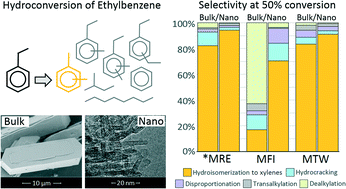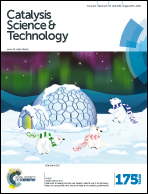Impact of pore topology and crystal thickness of nanosponge zeolites on the hydroconversion of ethylbenzene†
Abstract
The gas-phase hydroconversion of ethylbenzene was investigated in the presence of intimate mixtures of *MRE, MFI and MTW-type zeolite nanosponges and a hydrogenating component (Pt/Al2O3). The nanomorphic zeolites were prepared using multiammonium surfactants acting as dual-porogenic agents directing the formation of micro- and mesopores simultaneously. The effects of the zeolite topology (pore size and dimensionality) and crystal thickness on the product selectivity of ultra-thin zeolite frameworks (<10 nm) were investigated. The enhanced catalytic activity confirmed the importance of improved molecular diffusion. These nanosponges were unique in producing more xylenes, suggesting lower confinement effects. The selectivity for p-xylene and the selectivity towards ethylbenzene hydroisomerization, dealkylation, disproportionation, transalkylation and hydrocracking were evaluated. Despite the similar <10 nm crystal thickness of all the nanosponge zeolites, the presence of spacious channel interconnections in MFI was concluded to remarkably impact the product selectivity compared to straight channels as in *MRE and MTW. Our findings clarify the relatively unexplored transformation of alkyl-aromatics over ultra-thin zeolite crystals, through five typical catalytic reactions of major industrial interest.

- This article is part of the themed collection: Catalysis on Zeolites

 Please wait while we load your content...
Please wait while we load your content...